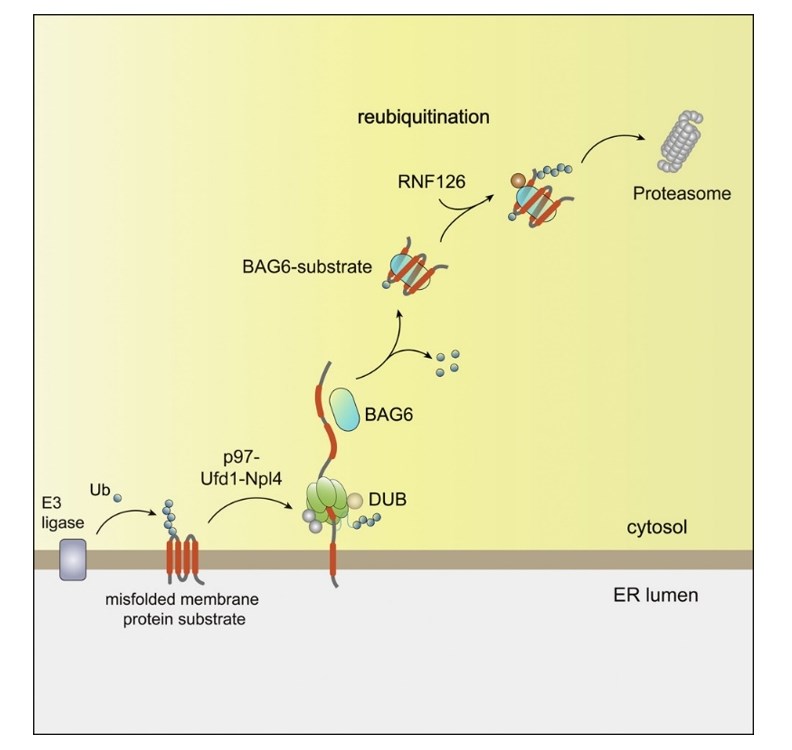What is RNF126 Protein
RNF126, or Ring Finger Protein 126, is a crucial member of the E3 ubiquitin-protein ligase family. This family of proteins plays a pivotal role in the ubiquitin-proteasome system, responsible for regulating protein degradation within cells. The official full name of RNF126 is "Ring Finger Protein 126," and it is alternatively known by the synonyms TRAC-1 (TRPC channel-associated factor 1) and ZNRF3 (zinc and ring finger 3). Its structural characteristics include a distinctive ring finger domain, a feature common among E3 ubiquitin ligases, which facilitates the transfer of ubiquitin molecules onto target proteins.
RNF126's Classification and Recent Research Advances
Belonging to the RBR (RING-between-RING) E3 ligase subclass, RNF126 distinguishes itself with its unique mode of ubiquitination. Recent research has shed light on its significance in diverse cellular processes. One notable advance includes the identification of RNF126 as a key player in regulating protein turnover and maintaining cellular homeostasis. The protein has been implicated in various physiological and pathological conditions, making it an intriguing subject of investigation.
RNF126 Biological Functions and Molecular Mechanisms
RNF126 is a multifaceted protein with intricate biological functions. Its primary role lies in the ubiquitin-proteasome system, where it acts as a molecular tagger for proteins marked for degradation. By facilitating the attachment of ubiquitin molecules to specific protein targets, RNF126 orchestrates their timely removal from the cell. This process is crucial for maintaining cellular health, preventing the accumulation of damaged or unnecessary proteins.
At the molecular level, RNF126 interacts with target proteins and collaborates with the ubiquitin-conjugating enzymes to catalyze the addition of ubiquitin moieties. The ubiquitinated proteins are then recognized by the proteasome, a cellular machinery responsible for degrading tagged proteins. This tightly regulated process ensures the elimination of proteins that could otherwise compromise cellular function.

Figure 1. RNF126-mediated reubiquitination. (Hu X, et al., 2020)
RNF126 Related Signaling Pathway
The signaling pathways involving RNF126 are intricate and interconnected, reflecting its role as a master regulator of protein degradation. One such pathway involves the TRPC (Transient Receptor Potential Canonical) channels, where RNF126 influences their stability and activity. This interaction has implications for cellular processes such as calcium signaling, impacting diverse physiological functions.
RNF126 Related Diseases
Dysregulation of RNF126 has been implicated in various diseases, highlighting its clinical relevance. For instance, studies have linked abnormal RNF126 activity to certain cancers, suggesting its involvement in tumorigenesis. The precise mechanisms underlying these associations are under intense investigation, opening new avenues for targeted therapies and diagnostic strategies.
RNF126's Applications in Biomedicine
The unique properties of RNF126 make it a promising candidate for various biomedical applications. In diagnostics development, RNF126 could serve as a biomarker for diseases characterized by its dysregulation, facilitating early detection and monitoring. Moreover, its involvement in the ubiquitin-proteasome system positions it as a potential target for therapeutic interventions, opening avenues for drug development.
In the realm of vaccine development, understanding the role of RNF126 in immune regulation provides insights into enhancing vaccine efficacy. Modulating RNF126 activity could potentially influence the immune response, contributing to the design of more effective vaccines against infectious agents and diseases.
Recommended Products
| Cat.# | Product name | Species | Source (Host) | Tag |
|---|---|---|---|---|
| RNF126-2335H | Recombinant Human RNF126 protein, His-tagged | Human | E.coli | His |
| RNF126-3927R | Recombinant Rhesus monkey RNF126 Protein, His-tagged | Rhesus Macaque | Mammalian Cell | His |
| RNF126-3744R | Recombinant Rhesus Macaque RNF126 Protein, His (Fc)-Avi-tagged | Rhesus Macaque | HEK293 | His (Fc)-Avi |
| RNF126-5340Z | Recombinant Zebrafish RNF126 | Zebrafish | Mammalian Cell | His |
| RNF126-1482C | Recombinant Chicken RNF126 | Chicken | Mammalian Cell | His |
Reference
- Hu X, et al. RNF126-mediated reubiquitination is required for proteasomal degradation of p97-extracted membrane proteins. Molecular Cell. 2020, 79(2): 320-331. e9.

